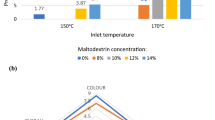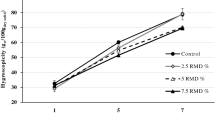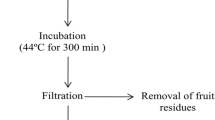Abstract
Lemon juices clarified with enzymatic treatment with and without cation exchange resin treatment were concentrated to 60o Brix in a vacuum evaporator and converted into powders by foam mat drying technique. Powders obtained from cation exchange resin treated juice were better in quality with respect to acidity, glucose, fructose, sugars, and ascorbic acid contents as compared to those prepared form non treated juice. Further, during 9 months storage, the powders suffered slight loss of acidity, and increase in reducing sugars i.e. glucose and fructose and considerable loss (31–55%) in vitamin C contents. Storage conditions did not bring about any significant change in the ash and hesperidin content of the product. But some losses were registered in the total phenols (23.69%) and sensory quality (from 7.72 to 7.26) of the powders. Further, the powders prepared from cation exchange resin treated juice and those pulverized with cane sugar suffered overall lesser changes in most of the quality parameters during 9 months of storage, thus indicating that, the treatment of lemon juice with cation exchange resin is beneficial for better initial product quality and pulverization of prepared powder with cane sugar is beneficial in reducing the hygroscopicity and retention of quality in a better way.

Similar content being viewed by others
References
Amerine MA, Pangborn RM, Roessler EB (1965) Principles of sensory evaluation of food. Academic, London
AOAC (1984) Official methods of analysis, 14th edn. Association of Official Analytical Chemists, Arlington
AOAC (1995) Official methods of analysis, 16th edn. Association of Official Analytical Chemists, Arlington
Cilliers JJL, Singleton VL (1989) Non enzymatic autoxidative phenolic browning reactions in caffeic acid model system. J Agric Fd Chem 37:890–896
Cochran WG, Cox GW (1967) Experimental designs. Wiley, New York, p613
Davis WB (1947) Determination of flavanones in citrus fruits. Anal Chem 19:476–478
Ranganna S (1997) Handbook of analysis and quality control for fruit and vegetable products, 2nd edn. Tata McGraw Hill Pub Co Ltd, New Delhi, p1112
Sharma PC, Sharma SK, Kaushal BBL (2001a) Preparation and evaluation of some value added products from lemon (Citrus pseudolimon Tan.) fruits. Indian J Agric Sci 71(11):691–694
Sharma SK, Sharma PC, Kaushal BBL (2001b) Effect of storage temperatures and folds of concentrations on quality characteristics of Galgal (Citrus pseudolimon Tan.) juice concentrates. J Food Sci Tech 38(6):553–556
Sharma PC, Sharma SK, Kaushal BBL (2002) Studies on the preparation of foam mat dried hill lemon (Citrus pseudolimon Tan.) juice powder. Indian Food Packer 56(4):67–71
Sharma SK, Kaushal BBL, Sharma PC (2004a) Effect of temperature and removal of amino acids on non-enzymatic browning of lemon juice concentrates during storage. J Sci Ind Res 63:444–451
Sharma SK, Sharma PC, Kaushal BBL (2004b) Storage studies of foam mat dried Hill lemon (Citrus pseudolimon Tan.) juice powder. J Food Sci Tech 41(1):9–13
Sharma SK, Kaushal BBL, Sharma PC (2005) Technology refinement for preparation of foam mat dried hill lemon juice powder. Indian Food Packer 59(1):75–82
Sharma SK, Kaushal BBL, Sharma PC (2006) Reduction of non-enzymatic browning of lemon juice concentrates by removal of reaction substrates. J Food Sci Tech 43(1):83–88
Sharma SK, Kaushal BBL, Sharma PC (2009) Effect of cation exchange resin treatment and addition of anti-caking agent on non-enzymatic browning of lemon juice powder during storage. J Sci Ind Res 68:611–616
Thimmaiah SK (1999) Standard methods of biochemical analysis. Kalyani Pub, New Delhi, pp 287–288
Ting SV, Deszyck EJ (1960) Total amino acid content of chilled orange juice and frozen concentrate. Proc Fla Stale Hort Soc 73:252–257
Author information
Authors and Affiliations
Corresponding author
Rights and permissions
About this article
Cite this article
Sharma, S.K., Kaushal, B.B.L. & Sharma, P.C. Effect of cation exchange resin treatment and addition on sugar as anti-caking agent on retention of nutritional and sensory quality of lemon juice powder during storage. J Food Sci Technol 48, 296–304 (2011). https://doi.org/10.1007/s13197-010-0183-1
Revised:
Accepted:
Published:
Issue Date:
DOI: https://doi.org/10.1007/s13197-010-0183-1




